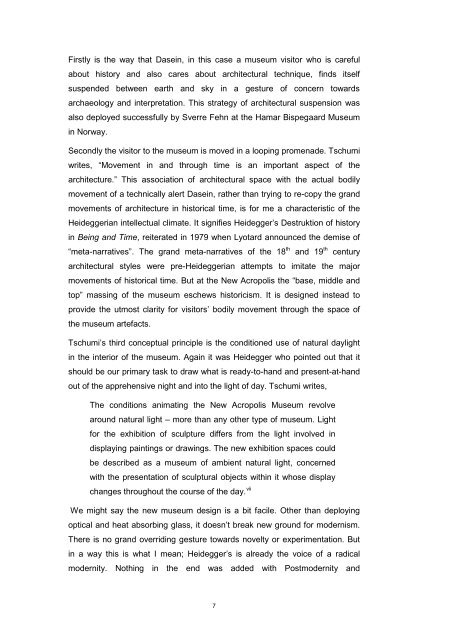Within-time-ness and history.pdf - ResearchSpace@Auckland
Within-time-ness and history.pdf - ResearchSpace@Auckland
Within-time-ness and history.pdf - ResearchSpace@Auckland
Create successful ePaper yourself
Turn your PDF publications into a flip-book with our unique Google optimized e-Paper software.
Firstly is the way that Dasein, in this case a museum visitor who is careful<br />
about <strong>history</strong> <strong>and</strong> also cares about architectural technique, finds itself<br />
suspended between earth <strong>and</strong> sky in a gesture of concern towards<br />
archaeology <strong>and</strong> interpretation. This strategy of architectural suspension was<br />
also deployed successfully by Sverre Fehn at the Hamar Bispegaard Museum<br />
in Norway.<br />
Secondly the visitor to the museum is moved in a looping promenade. Tschumi<br />
writes, “Movement in <strong>and</strong> through <strong>time</strong> is an important aspect of the<br />
architecture.” This association of architectural space with the actual bodily<br />
movement of a technically alert Dasein, rather than trying to re-copy the gr<strong>and</strong><br />
movements of architecture in historical <strong>time</strong>, is for me a characteristic of the<br />
Heideggerian intellectual climate. It signifies Heidegger’s Destruktion of <strong>history</strong><br />
in Being <strong>and</strong> Time, reiterated in 1979 when Lyotard announced the demise of<br />
“meta-narratives”. The gr<strong>and</strong> meta-narratives of the 18 th <strong>and</strong> 19 th century<br />
architectural styles were pre-Heideggerian attempts to imitate the major<br />
movements of historical <strong>time</strong>. But at the New Acropolis the “base, middle <strong>and</strong><br />
top” massing of the museum eschews historicism. It is designed instead to<br />
provide the utmost clarity for visitors’ bodily movement through the space of<br />
the museum artefacts.<br />
Tschumi’s third conceptual principle is the conditioned use of natural daylight<br />
in the interior of the museum. Again it was Heidegger who pointed out that it<br />
should be our primary task to draw what is ready-to-h<strong>and</strong> <strong>and</strong> present-at-h<strong>and</strong><br />
out of the apprehensive night <strong>and</strong> into the light of day. Tschumi writes,<br />
The conditions animating the New Acropolis Museum revolve<br />
around natural light – more than any other type of museum. Light<br />
for the exhibition of sculpture differs from the light involved in<br />
displaying paintings or drawings. The new exhibition spaces could<br />
be described as a museum of ambient natural light, concerned<br />
with the presentation of sculptural objects within it whose display<br />
changes throughout the course of the day. vii<br />
We might say the new museum design is a bit facile. Other than deploying<br />
optical <strong>and</strong> heat absorbing glass, it doesn’t break new ground for modernism.<br />
There is no gr<strong>and</strong> overriding gesture towards novelty or experimentation. But<br />
in a way this is what I mean; Heidegger’s is already the voice of a radical<br />
modernity. Nothing in the end was added with Postmodernity <strong>and</strong><br />
7















